Note: If an image ever fails to appear - refresh your page, it really is there
Flags of the United States of America
This page is Currently Under Construction
and just a place holder for the final page. Historically, the armed forces of the United States were defined in terms of the land and naval forces of the United States, as described in the Constitution. The land force is the United States Army and its components. The US Air Force is derived from the US Army Air Corps. The Army has reconstituted the former Air Corps as a branch within the Army. (Interestingly enough, some think that the Air Force is currently qualifying more drone "pilots" than it is aircraft pilots.) The naval forces of the United States are the U.S. Navy, and its reserve components. There are two additional uniformed services, the Marines, and the U.S. Coast Guard, who both operate as a part of the naval forces during wartime.
Flags of the United States Army
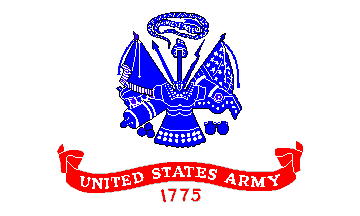
US Army Flag
|
Flag of the United States Army (outdoor/all weather)
The United States Army is a branch of the US armed forces responsible for land-based military operations. It is the largest and oldest branch of the US military.
|

US Army Flag
(ceremonial flag)
|
Flag of the United States Army (ceremonial)
This version of the United States Army flag is used for parades, indoors, and ceremonial occasions, fringes just don't stand up to frequent outdoor use.
|
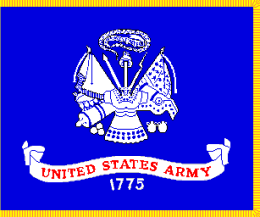
US Army Field Flag
|
Flag of the United States Army (field)
The high cost of the Army Flag (due to the fact that it must be issued with the full set of embroidered campaign streamers) led to the development of the Army Field Flag. It is identical in design to the Army Flag except that the main colors are reversed (ultramarine blue field, white insignia, yellow fringe) and no campaign streamers are authorized. Dimensions are 3' at the hoist by 4' at the fly. Like the Army Flag, this flag is intended to be displayed indoors or carried on parade.
|
Leadership Flags of the United States Army
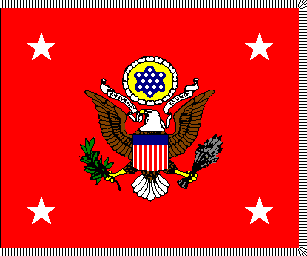
Secretary of Army Flag
|
Flag of the Secretary of Army 1906-1956
The Secretary of the Army is the civilian head of the Department of the Army and reports to the Secretary of Defense. The Secretary of the Army is responsible for all matters relating to the U.S. Army.
|
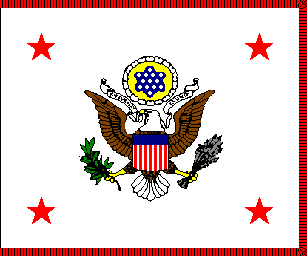
USoA Flag
|
Under Secretary of the Army
Positional Color, Under Secretary of the Army. This flag is similar to the Secretary's flag, but with colors reversed -- white field, red stars -- and a red fringe. It is displayed with cord and tassels of red and white.
|

ASoA Flag
|
Assistant Secretary of the Army
Positional Color, Offices of the Assistant Secretaries of the Army. Like the color for the Under Secretary, but the stars and fringe are "national flag" blue; cord and tassels are "national flag" blue and white.
|
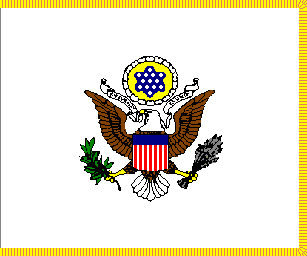
Flag
|
Principal Staff Assistants to the Secretary of the Army
Positional Color, Offices of the Principal Staff Assistants to the Secretary of the Army. This attractive color is authorized for the Secretary's chief bureaucratic assistants, e.g. the Chief of Public Affairs and the Auditor General.
|
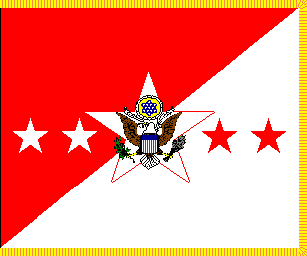
CoS Flag
|
Army Chief of Staff
Positional Color, Chief of Staff, U.S. Army. This color is used by the Chief of Staff in lieu of the rank flag (red with four white stars and yellow fringe) that would normally be displayed by a four-star general. It is displayed with cord and tassels of red and white.
|
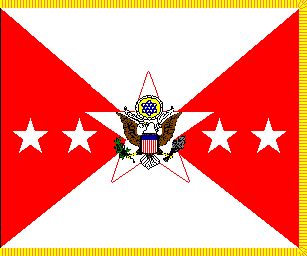
VC0S Flag
|
Army Vice Chief of Staff
Positional Color, Vice Chief of Staff, U.S. Army. Similar to the Chief of Staff's color, but quartered diagonally. This color is displayed with cord and tassels of red and white.
|
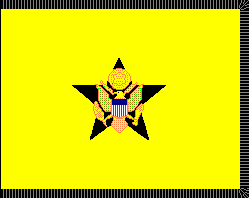
DoAS Flag
|
Director of the Army Staff
Positional Color, Director of the Army Staff. The badge is the branch insignia of the General Staff. The black and yellow of this color derive from the cords of mixed black and gold that used to be worn by staff officers on the campaign hat. The Director of the Army Staff is a lieutenant general (three stars); he is the Army's top operations officer. This flag is also the positional color for the Deputy Chiefs of Staff
|
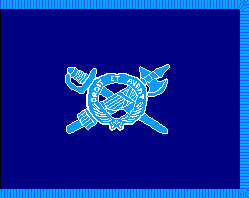
AIG Flag
|
Army Inspector General
The motto on the branch badge is Droit Et Avant (Right and Forward).
|
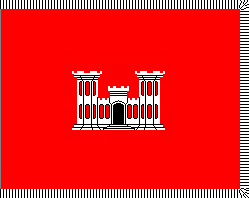
COE Flag
|
Army Chief of Engineers
Flags representing individual officers and officials are either "positional colors" or "individual flags." The Corps of Engineers is not a major Army command, but a branch of service, and therefore has no organizational flag. It does have a "whole-branch" organizational color.
Chief of Engineers' positional color is a scarlet field with white fringe and the COE branch insignia--the twin-towered castle--in white.
The situation is somewhat complicated by the fact that the civil branch of the COE does use a scarlet flag with the insignia in white, sans fringe, as a vessel flag and as a distinguishing flag at non-military installations. This flag is also often flown at the headquarters of the post engineer on many Army installations, though regulations prohibit this.
|
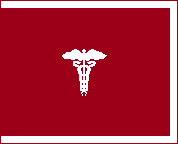
SG Flag
|
Army Surgeon General
|
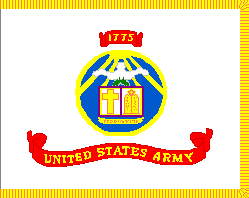
COC Flag
|
Army Chief of Chaplains
Positional Color, Office of the Chief of Chaplains. The badge is an adaption of the distinctive unit insignia of the Chaplain's Corps. On the open pages of the book are the branch insignias of Christian and Jewish chaplains. The inscription on the small scroll beneath the badge reads PRO DIO ET PATRIA ("For God and Country").
|
|
|
Christian Faith Chapel Flag |
|
Jewish Faith Chaplain's Flag |
The Chapel flags are used only in chapels on Army installations, and are always displayed with the U.S. National Flag.
|
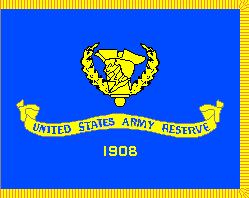
COAR Flag
|
Chief of Army Reserve
Positional Color, Office of the Chief of the U.S. Army Reserve. The two-star general who heads the Army Reserve (but not the National Guard) displays this flag. The badge, showing the head of a colonial soldier within a wreath, is the insignia of the USAR. The numerals beneath the scroll refer to the ear in which the USAR was founded.
|
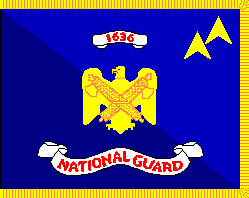
USACONGB Flag
|
Army Chief of National Guard Bureau
Positional Color, Office of the Chief, National Guard Bureau. This officer represents both the Army National Guard and the Air National Guard. Accordingly, his flag is a diagonal bicolor with dark blue (for the Army) on the bottom and ultramarine blue (for the Air Force) on top. The badge in the center of the flag is the branch insignia of the Natioanl Guard Bureau; it dates from the turn of the century. The two triangles in the upper fly are "flight devices" meant to symbolize the Air National Guard.
The 1998 update to AR 840-10 indicates that the Positional Color of the Chief, National Guard Bureau has been modified. Two scrolls have been added: a small one above the insignia with the date 1636 and a large one below the insignia with the inscription NATIONAL GUARD.
|
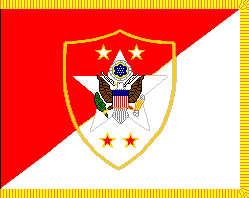
SMOA Flag
|
Sergeant Major of the Army
On 16 June 1999, Army Chief of Staff Gen. Dennis J. Reimer officially unveiled and presented the Sergeant Major of the Army Flag to the residing Sgt. Maj. of the Army, Robert E. Hall.
The flag, designed by the U.S. Army Institute of Heraldry, was taken from the insignia created in 1966 to distinguish the SMA rank. The flag background is divided diagonally from the upper fly to lower hoist, in scarlet and white, with scarlet uppermost. The insignia of the SMA is centered on the flag with the fringe in yellow, cord and tassels in scarlet and white
|
Rank Flags of the United States Army
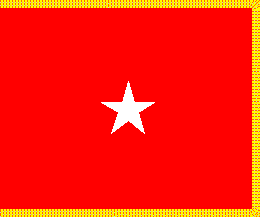
One Star General's Flag
|
Army Brigadier General
The positional flags of the Army are red (maroon for general officers of the Army Medical Department and purple for general officers of the Chaplain's Corps) with the stars disposed horizontally.
|
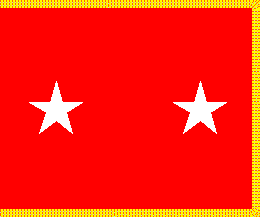
Two Star General's Flag
|
Army Major General
|
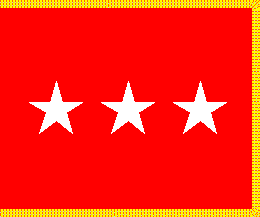
Three Star General's Flag
|
Army Lieutenant General
|
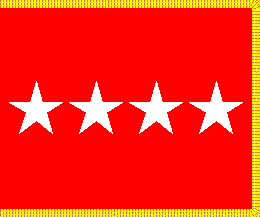
Four Star General's Flag
|
Army General
|
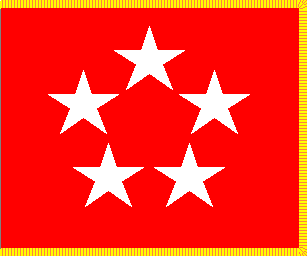
Five Star General's Flag
|
General of the Army
A late 19th century law on the organization of the Army authorized one general and specified that he would have the title "General of the Armies of the United States."
|

Washington's Flag
|
Commander-in-Chief of the Armies of the United States
In 1776 Congress conferred upon General George Washington the title "" so as to uniquely identify him. No insignia or flag were authorized. Washington only ever wore three silver six-pointed stars as an insignia of grade and a light blue ribbon/sash diagonally across his chest indicating his status as Commander-in-Chief of the Continental Army.
His flags as C-I-C were all blue of varying shades with 13 six-pointed stars arranged either 3-2-3-2-3, 4-5-4, or in a circle. There is a surviving flag in Valley Forge which is claimed to be Washington's command flag with the star arranged 3-2-3-2-3. The other arrangements are from period paintings.
|
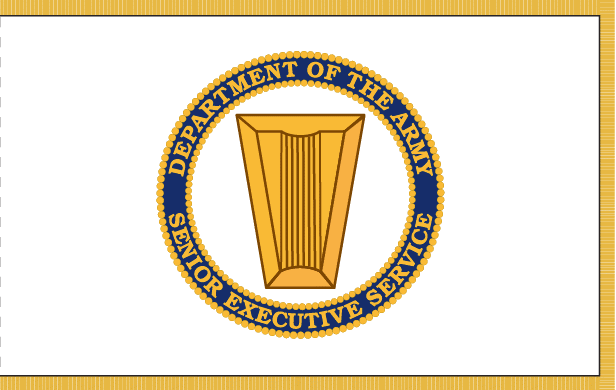
SES Flag
|
Department of the Army Senior Executive Service Flag
|
Branch Flags of the United States Army
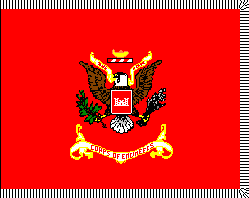
COE Flag
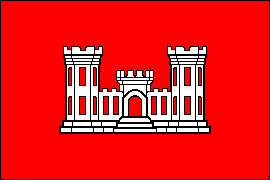
COE Vessel Flag |
Army - Corps of Engineers
Organizational Color, The Corps of Engineers. The Corps of Engineers is classed as a "whole-branch" regiment (rather like the British Royal Artillery) and as such it has its own organizational color. The separate TOE battalions of the Corps have similar colors, with their own shields, crests, mottos and designations. The Corps' one-word motto, ESSAYONS, is repeated on both sides of the motto scroll. Red and white are the Corps of Engineers branch colors.
|
|
|
Division Engineer Pennant |
|
District Engineer Pennant |
Vessel Flag, Corps of Engineers. This flag is also authorized to be flown on land by Corps of Engineers facilities that are not located on Army installations. It dates from the early part of this century. Originally intended for vessels it is now used by divisions, districts, laboratories, offices and facilities of that corps. See AR 840-10 Chapter 7-7 for full details.
|
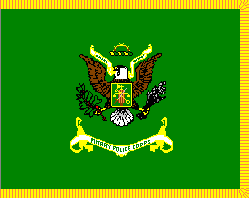
MP Flag
|
Army Military Police Corps
Organizational Color, Military Police Corps. The MP Corps is a "whole-branch" regiment; this color represents the Corps as a whole. Green and yellow are the MP branch colors. The crest consists of crossed flintlock pistols, the MP branch insignia. MP battalions have similar colors with their own coats of arms, and their unit designation on the scroll.
|
Organizational Flags of the United States Army

Band Flag
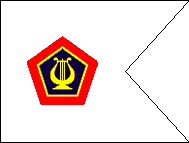
Army Field Band Guidon
|
US Army Field Band
The U.S. Army Band, "Pershing's Own," is authorized a distinctive flag. It is white with yellow fringe and bears the COA of the U.S. Army Band in proper colors. The U.S. Army Field Band (a component of the U.S. Army Band) has a distinctive guidon. Other Army bands have guidons of the pattern authorized for units of the Adjutant General's Corps.
An additional note on the Army Band Flag: The U.S. Army Band served overseas in the European Theater, 1943-45 and actually qualified for a campaign credit. Accordingly, the Band's flag bears a single streamer -- European Theater with inscription RHINELAND.
The United States Army Field Band, Headquartered at Fort George G. Meade, Maryland, is the Army's primary touring band. Besides performing as a traditional marching band, it has a number of other components such as the Soldier's Chorus and the Jazz Ambassadors. The Field Band is distinct from the United States Army band (Pershing's Own).
The Field Band is authorized a guidon, white with the band's shoulder sleeve insignia in proper colors centered (attached as us-usafb).
|
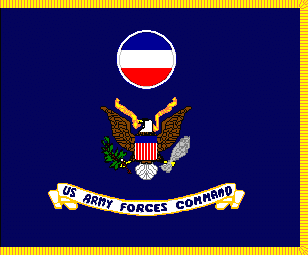
FORSCOM Flag
|
US Army Forces Command
Forces Command controls all US Army forces, Active, Reserve and National Guard, in the continental United States. Its principal mission is to maintain these forces in a deployable status according to current war plans. FORSCOM, as it is commonly known, has a secondary mission of continental defense. Some other Major Army Commands are Training and Doctrine Command and U.S. Army Europe.
Major commands of the US Army have flags with a field of "national flag" blue and yellow fringe. The Coat of Arms of the US, in proper colors (minus the crest) is centered between the command's shoulder sleeve insignia above and a designation scroll below.
|
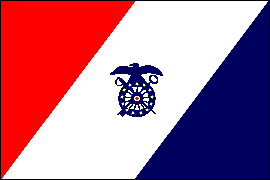
USATS Flag
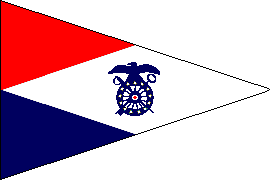
ATS Vessel Pennant
|
Army Transport Service
The U.S. Army Transport Service (part of the Quartermaster Corps) operated ships for the transport of units to overseas locations. These ships flew the National Ensign and Union Jack, and were also authorized a distinctive flag of diagonal red, white and blue stripes with the branch insignia of the Quartermaster Corps centered. Proportions were 2:3 and the flag was made in three sizes. Source: the 1923 and 1931 editions of AR 260-10
U.S. Army: Quartermaster Corps Pennant (1923) Per the 1923 edition of AR 260-10, vessels operated by the Quartermaster Corps, other than ships of the Army Transport Service, flew a triangular red, white and blue pennant with the branch insignia of the Quartermaster Corps centered in the white diamond-shaped portion. This pennant was made of bunting in two sizes: 4-foot hoist by 6-foot fly and 2-foot hoist by 3-foot fly. This pennant is not described in the 1931 edition of the regulation, so it was apparently abolished at some prior time.
|
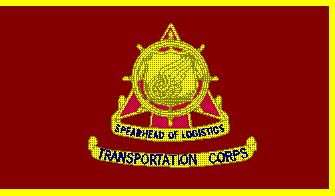
Transportation Corps Regiment
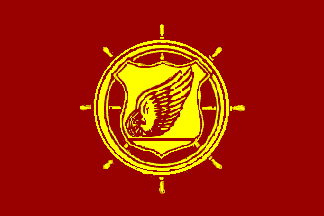
Transportation Corps Vessel Flag
|
Army Transportation Corps
The flag of my regiment, the U.S. Army Transportation Corps Regiment. The flag is brick red with a gold fringe. The crest depicts a ships wheel, a highway sign, a winged wheel on a rail-representing the different forms of transportation - all superimposed on an arrowhead brick red and gold-alluding to the regiment's motto "Spearhead of Logistics"-which appears in a gold scroll with blue letters.
Vessel Flag, Transportation Corps, U.S. Army. Army-operated ships and watercraft fly branch-specific vessel flags in addition to the National Ensign. For some reason, they not only come in several sizes but in two different proportions: 4:5 and 2:3; I have illustrated the latter. Vessel flags are in branch colors, in this case brick red and golden yellow for the Transportation Corps. The insignia is the branch badge as worn on the lapels of the Class "A" uniform jacket by commissioned officers. Most Army vessels are operated by either the Transportation Corps or the Corps of Engineers, though AR 840-10 also illustrates a vessel flag for the Signal Corps.
|
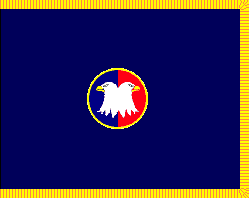
USARC Flag
|
US Army Reserve Command
USARC is broadly responsible for peacetime command and control of USAR units. It is also responsible, under FORCOM, for USAR organization, training and mobilization. The two-star general who commands USARC is also the Chief, Army Reserve.
Organizational Flag, US Army Reserve Command. "Designated Commands" of the Army, of which USARC is one, have flags with a "national flag" blue field, yellow fringe, and the command's shoulder sleeve insignia centered.
|
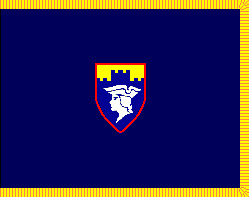
7th USARCOM Flag
|
7th Army Reserve Command
The 7th ARCOM is headquartered in Germany. Many of the civilian employees of the US Army in Germany are Army Reservists.
ARCOM's have organizational flags with a national flag blue field, yellow fringe, and the shoulder sleeve insignia (SSI), in proper colors, centered. Its SSI symbolizes the command's role: the shield shape and the battlements represent the European defense mission, and the Minuteman is the symbol of the USAR.
|
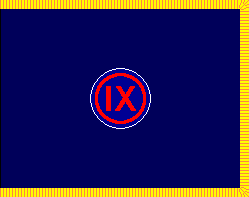
9th USARSC Flag
|
9th Army Regional Support Command
The peacetime chain of command for USAR units runs from US Army Forces Command through US Army Reserve Command to RSC's and ARCOM's. These headquarters units are responsible for command and control of USAR units in their geographical areas. When USAR units are called up for active duty, RSC's and ARCOM's mobilize them, prepare them for deployment and dispatch them.
The RSC has an organizational flag with a national flag blue field, yellow fringe, and the shoulder sleeve insignia (SSI), in proper colors, centered. This SSI was formerly used by IX US Army Corps.
|
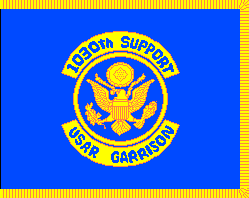
USAGSU Flag
|
U.S. Army Reserve Garrison Support Unit
This is an example of a flag for a Garrison Support Unit of the Army Reserve. The GSU performs the same kind of housekeeping and support functions for the USAR as the U.S. Army Garrison does for active units.
It has the same pattern of organizational flag - teal blue field with yellow fringe and the insignia for "branch immaterial" between two arcs inscribed with the unit designation.
|
Training Center and School Flags of the United States Army
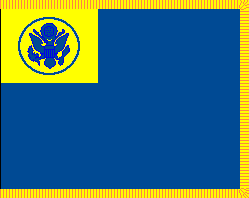
USATC Flag
|
General non-Branch Training Center
Organizational Flag, U.S. Army (non-Branch specific): U.S. Army Training Centers that are not oriented to branch (e.g. those providing basic training) have organizational flags with a teal blue field and a yellow canton bearing the insignia for "branch immaterial" (the USCOA within a ring), also teal blue. The fringe is yellow. Dimensions are 3 feet at the hoist by 4 feet on the fly. Brigades of the TC would have the same flag with the brigade number in the upper hoist, and battalions of the brigades would also have their battalion number under the canton, all numerals being yellow. Teal blue and yellow are the colors used for flags of most Army organizations that are not oriented to a branch of service
|
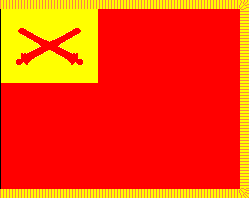
USAFATC Flag
|
Army Field Artillery Training Center
Organizational Flags for Field Artillery Training Centers: U.S. Army Training Centers (as distinct from U.S. Army Schools) have organizational flags with a field in the primary branch color and a canton in the secondary branch color. In the canton is the branch insignia in the primary branch color. Generally, the fringe is in the secondary branch color. In the case of Field Artillery, the branch colors are scarlet and yellow.
Training Brigade Flags would have a brigade number on the upper fly side quadrant of the flag, a training Battalion would have and an addition number on the lower hoist side quadrant.
There are five types of Training Centers: Armor, Engineer, Field Artillery, Infantry and Branch Immaterial. Brigades and battalions of Training Centers have designating numerals added to the basic flag.
|
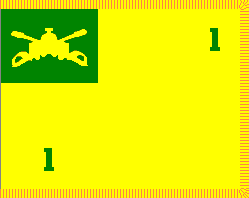
USAATC Flag
|
Army Armor Training Center
Organizational Flag, 1st Battalion, 1st Brigade, The Armor Training Center (Fort Knox, KY). The flag is in the Armor branch colors, yellow and green.
Training Brigade Flags would have a brigade number on the upper fly side quadrant of the flag, a training Battalion would have and an addition number on the lower hoist side quadrant.
|
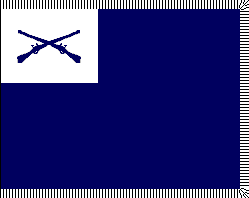
USAITC Flag
|
Army Infantry Training Center
Organizational Flags for Infantry Artillery Training Centers: like those for Field Artillery TC's, except for the colors and the branch insignia. Note that although the branch colors for Infantry are light blue and white, the field and insignia of these flags are national flag blue. This is also the field color for Infantry organizational colors, a traditional practice that recalls the old Standard of the United States and the regimental colors of the nineteenth century.
The branch insignia for Infantry is crossed muskets, nicknamed "idiot sticks" in the Army.
Training Brigade Flags would have a brigade number on the upper fly side quadrant of the flag, a training Battalion would have and an addition number on the lower hoist side quadrant.
|
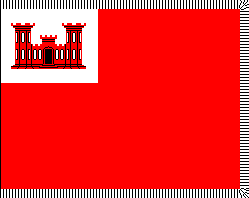
USAETC Flag
|
Army Engineer Training Center
Organizational Flag, The Engineer Training Center (Fort Leonard Wood, MO). Training centers (infantry, armor, field artillery and branch immaterial) all have flags of this pattern in branch colors (red and white for the Corps of Engineers) with the appropriate branch badge in the canton. For brigades of training centers, a numeral is added in the upper hoist; for battalions, another numeral is added below the canton.
|

USAFAS Flag
|
Army Field Artillery School
Organizational Flag, Training Battalion of a School Brigade, The Field Artillery School, Fort Sill, OK. The device in the canton comes from the distinctive unit insignia of the FA School. The organizational color of school brigades is the same pattern but with just the brigade number in the upper fly.
|
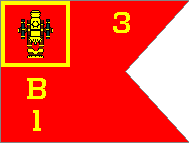
Battery "B" Guidon
|
Battery B, 1st Battalion, 3rd Brigade, The Field Artillery School
Guidon, Battery B, 1st Battalion, 3rd Brigade, The Field Artillery School (Ft. Sill, OK). The device in the canton is from the coat of arms of the FA School. The brigade number is in the upper fly; the battalion number and the battery letter are below the canton. Red and yellow are the FA branch colors. The FA School carries out all types of training for the FA branch: enlisted entry training, officer basic and advanced training, specialized training, etc.
|

USAIS Flag
|
Army Infantry School
Organizational Flag, The Infantry School, Fort Benning, GA. Branch-oriented Army schools have flags with a field in the first named branch color and a fringe in the second named branch color, with the authorized device centered. In the case of the Infantry School, the colors are light blue and white; the device is the shoulder sleeve insignia/distinctive unit insignia (the two are identical in design) of the school. Under the motto FOLLOW ME is a bayonet, point up.
|
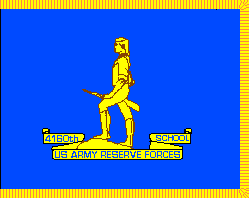
USARF Flag
|
Army Reserve Forces School
Organizational Flag, 4160th USARF School. Until recently, USARF Schools were primarily responsible for all USAR continuation training (NCO courses, staff courses, MOS reclassification training, special skills training, etc.). They are now being phased out, their mission having been handed over to the USAR Training Divisions. The organizational flags for USARF Schools is teal blue with yellow fringe and the Lexington Minuteman in yellow with brown details over a yellow scroll with the school's designation in teal blue. The 4160th USARF School, located in Kingsbury, IN, was inactivated in 1996.
|
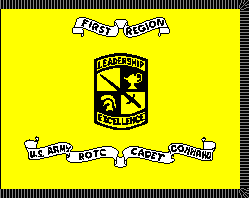
USAROTC Flag
|
Army ROTC Cadet Command
Organizational Flag, U.S. Army ROTC Cadet Command. The image above illustrates the flag of an ROTC Region; the flag for the Command as a whole is the same but without the scroll above the badge (which is the ROTC shoulder sleeve insignia) Cadet Command manages the college/university-based Reserve Officer Training Corps program, which actually produces the bulk of the Army's commissioned officers.
|
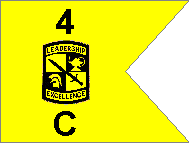
ROTC Senior Guidon
|
Army Senior ROTC Guidon
Senior (college-level) Reserve Officer Training Corps (ROTC) companies of programs that are not branch-oriented have yellow guidons with the ROTC shoulder sleeve insignia between the battalion number and the company letter.
|
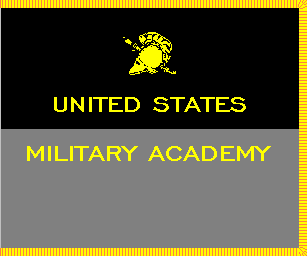
West Point Flag
|
West Point United States Military Academy
Organizational Flag, U.S. Military Academy (West Point). West Point, as distinct from the U.S. Corps of Cadets, has its own organizational flag in the same proportions as the Corps of Cadets' color (4:5). Black, gray and yellow are the USMA's traditional colors. The Greek helmet is also used as a collar (branch of service) insignia for wear by military personnel permanently assigned to the USMA, and it figures in the shoulder sleeve insignia, worn on the field uniform by cadets, and on all uniforms by personnel assigned to the Academy staff.
The Organizational Flag, U.S. Military Academy has the characteristics of an "office flag" or "display flag." It is never hoisted or carried in parades. The only colours that are ever carried on parade at West Point are the National Colours, the U.S. Corps of Cadets Colours, and for 2002, the USMA Bicentennial Commemorative Flag.
|
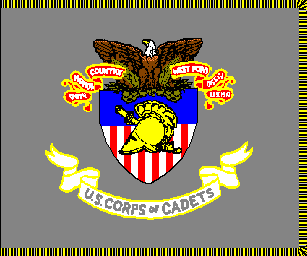
Corps of Cadets Flag
|
United States Military Academy Corps of Cadets
U.S. Army Organizational Color, U.S. Corps of Cadets (West Point). Two of the U.S. Army's color-bearing organizations, the U.S. Corps of Cadets (West Point) and the 1st Battalion, 3rd Infantry Regiment (The Old Guard) have colors proportioned 4:5. All others are 3:4.
The color of the Corps of Cadets has a black, gray and yellow fringe and is always displayed with cord and tassels in the same colors. My image is based on the official illustration and description in AR 840-10 -- which unfortunately omits to mention the colors for the scroll and title.
|
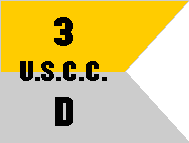
West Point Guidon
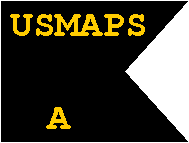
USMA Preparatory School
|
West Point United States Military Academy Guidons
The U.S. Corps of Cadets (U.S. Army Military Academy, West Point) is organized into three regiments, each consisting of a number of companies. Each company has two guidons. The "dress" guidon displays the regimental number and the company letter above and below the initials "U.S.C.C."
The "field" guidon just has the regimental number. The colors are officially described as golden yellow and silver gray.
West Point Prep Guidons
The United States Military Academy Preparatory School (USMAPS), sometimes referred to as West Point Prep, is a preparatory school for the United States Military Academy (USMA). Admission to USMAPS is seen as alternate route to get acceptance to attend West Point and ensure that Cadets are better qualified for the academic, and military training.
|
Flags of the United States Navy
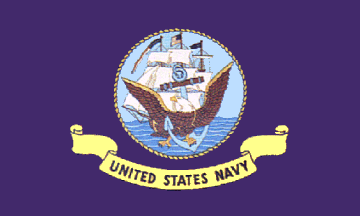
US Navy Flag
|
Flag of the United States Navy
The United States Navy is a branch of the U.S. armed forces responsible for sea-based warfare. The U.S. Navy is the largest navy in the world. Its mission is to maintain, train, and equip combat-ready naval forces capable of winning wars, deterring aggression, and maintaining freedom of the seas.
|
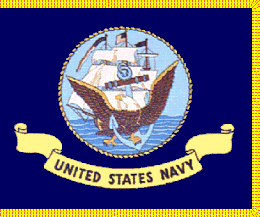
US Navy Flag
(ceremonial)
|
Flag of the United States Navy (ceremonial)
This version of the United States Navy flag is used for parades, indoors, and ceremonial occasions, fringes just don't stand up to frequent outdoor use.
|

Secretary of Navy Flag
|
Flag of the Secretary of Navy 1867-1959
The Secretary of the Navy is the civilian head of the Department of the Navy and reports to the Secretary of Defense.
|
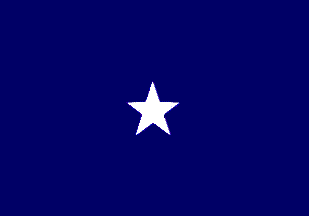
One Star Admiral Flag
(outdoor)
|
Navy Rear Admiral (Lower Half)
In the United States Navy Rear Admiral (lower half) (RDML) is a one-star flag officer. Rear admiral (lower half) ranks above captain and below rear admiral. Rear admiral (lower half) is equivalent to the rank of brigadier general in the other uniformed services, and equivalent to the rank of commodore in most other navies. In the United States uniformed services, rear admiral (lower half) replaced the rank of commodore in 1985.
|
|
|
Navy Rear Admiral
Lower Half (cermonial) |
|
Restricted Line Officers
|
Restricted Line Officers are officers not eligible to command at sea, such as Supply, Medical, and JAG Officers. |
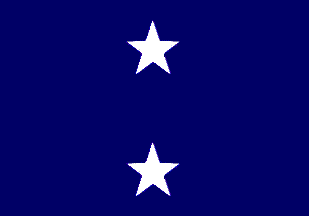
Two Star Admiral Flag
(outdoor)
|
Navy Rear Admiral (Upper Half)
In the United States Navy a Rear Admiral, also referred to as Rear Admiral (upper half), is a two-star flag officer. Rear admiral ranks above rear admiral (lower half) and below vice admiral. Rear admiral is equivalent to the rank of major general in the other uniformed services. It is the highest permanent rank during peacetime in the uniformed services; all higher ranks are temporary ranks linked to specific positions (although virtually all officers who are promoted to three-star rank or higher are approved to retire at their highest earned rank).
|
|
|
Navy Rear Admiral - Upper Half (ceremonial) |
|
Restricted Line Officers |
Restricted Line Officers are officers not eligible to command at sea, such as Supply, Medical, and JAG Officers.
|
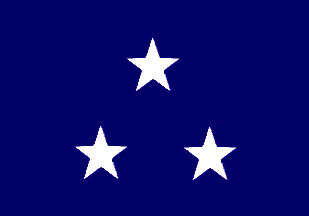
Three Star Admiral Flag
(outdoor)
|
Navy Vice Admiral
A vice admiral in the United States Navy typically commands one of the five numbered U.S. naval fleets, which have both wartime and peacetime missions. A notch below full admiral and just above rear admiral, the holders of this rank sport three five-pointed silver stars on their uniform and a shoulder board with three stripes. Their command flag is three white stars set against a blue backdrop.
|
|
|
Navy Vice Admiral (ceremonial) |
|
Restricted Line Officers |
Restricted Line Officers are officers not eligible to command at sea, such as Supply, Medical, and JAG Officers.
|
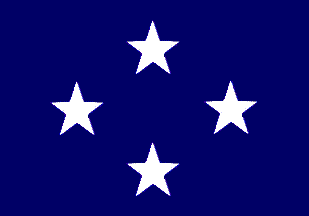
Four Star Admiral Flag
(outdoor)
|
Navy Admiral
An admiral is a top commissioned officer in the United States Navy, on par with a U.S. Army general, and is outranked only by a fleet admiral. However, fleet admiral is no longer considered an active rank – there have been none appointed since World War II – making admiral effectively the topmost naval rank. Admirals wear four silver five-point stars and shoulder boards with four gold stripes to indicate their rank.
|
|
|
Navy Admiral (ceremonial) |
|
Restricted Line Officers |
Restricted Line Officers are officers not eligible to command at sea, such as Supply, Medical, and JAG Officers.
|
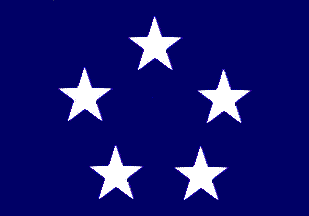
Five Star Admiral Flag
(outdoor)
|
Navy Fleet Admiral
A Fleet Admiral of the United States Navy (FADM) is a five-star flag officer rank, and it is considered to be the highest possible rank attainable in the United States Navy. Fleet Admiral ranks immediately above admiral and is equivalent to General of the Army and General of the Air Force. The Fleet Admiral rank is reserved for wartime use only and the grade is not currently active.
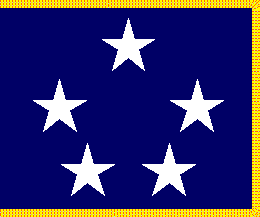 Navy Fleet Admiral (ceremonial) Navy Fleet Admiral (ceremonial) There have been no (five-star) Fleet Admirals appointed since World War II; therefore the relevant rank flag, though authorized and official, is not flown now.
|
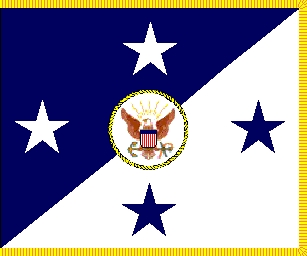
CNO Flag
|
Navy Chief of Naval Operations
Like the color of the Chief of Staff, U.S. Army, the CNO's color is a diagonal bicolor, in this case dark blue over white. In the center is the badge of the Navy. The stars are arranged in a diamond pattern, as for the rank flag of a full admiral. Dimensions are 4' 4" at the hoist by 5' 6" on the fly with 2 1/2" fringe--the same as for the colors of the other services' chiefs of staff/commandants.
|
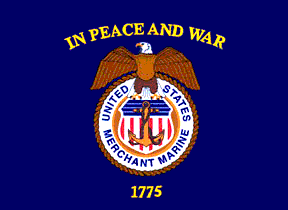
USMM Flag
|
US Merchant Marine
|
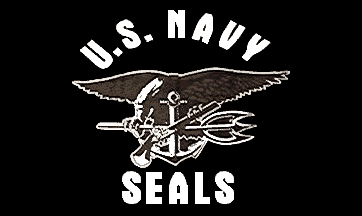
SEAL Flag
|
US Navy Seals
|
Flag
|
Flag
|
Flag
|
Flag
|
Flag
|
Flag
|
Flag
|
Flag
|
Flag
|
Flag
|
Flag
|
Flag
|
Flag
|
Flag
|
Flag
|
Flag
|
Flags of the United States Air Force
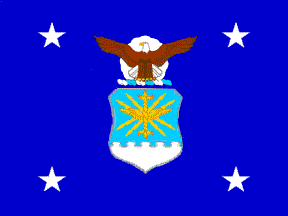
Secretary of Air Force Flag
|
Flag of the Secretary of Air Force
The Secretary of the Air Force is the civilian head of the Department of the Air Force and reports to the Secretary of Defense.
|

US Air Force Flag
|
Flag of the United States Air Force
The United States Air Force is a branch of the U.S. armed forces responsible for aerial warfare, space warfare, and cyber warfare. It was initially part of the U.S. Army and was formed as a separate branch in 1947.
|
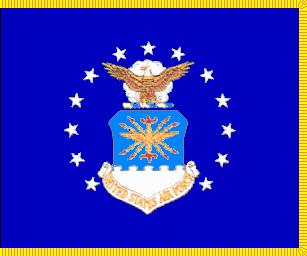
US Air Force Flag
(Ceremonial)
|
Flag of the United States Air Force (Ceremonial)
The United States Air Force, like the US Coast Guard, has two distinctive flags. One is a flag use at all air bases and establishments; the other is a military standard for use on ceremonial occasions.
|
SAC Flag
|
Strategic Air Command 1946-1992
|
Flag
|
Flag
|
Flag
|
Flag
|
Flag
|
Flag
|
Flag
|
Flag
|
Flag
|
Flag
|
Flag
|
Flag
|
Flag
|
Flag
|
Flag
|
Flag
|
Flag
|
Flag
|
Flag
|
Flag
|
Flag
|
Flag
|
Flag
|
Flag
|
Flag
|
Flag
|
Flag
|
Flag
|
Flag
|
Flag
|
Flags of the United States Marine Corps
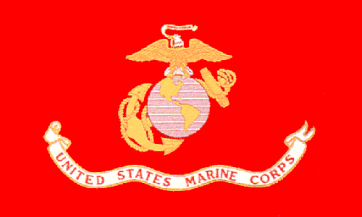
US Marines Flag
|
Flag of the United States Marine Corps
The United States Marine Corps is a branch of the U.S. armed forces responsible for providing force protection from the sea. The Marine Corps is a component of the Department of the Navy; however, in the military leadership structure, the Marine Corps is a separate branch.
|
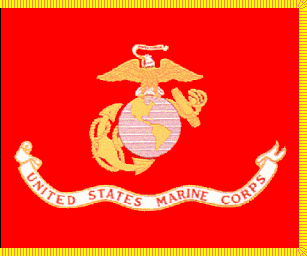
US Marine Corps Flag
(ceremonial)
|
Flag of the United States Marine Corps (ceremonial)
This version of the Marine Corps flag is used for parades, indoors, and ceremonial occasions, fringes don't stand up to frequent outdoor use.
|
Flag
|
Flag
|
Flag
|
Flag
|
Flag
|
Flag
|
Flag
|
Flag
|
Flag
|
Flag
|
Flag
|
Flag
|
Flag
|
Flag
|
Flag
|
Flag
|
Flag
|
Flag
|
Flag
|
Flag
|
Flag
|
Flag
|
Flag
|
Flag
|
Flag
|
Flag
|
Flag
|
Flag
|
Flag
|
Flag
|
Flag
|
Flag
|
Flags of the United States Coast Guard
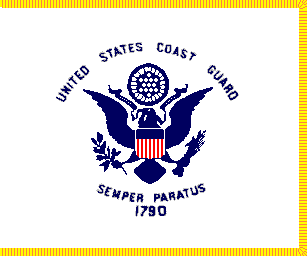
US Coast Guard Flag
(ceremonial)
|
Flag of the United States Coast Guard (ceremonial)
Although the United States Coast Guard is not part of the Department of Defense, it is considered a branch of the military. Formally, today it is part of the Homeland Defense Department today, but began as part of the US Customs in 1790 as the US Revenue Cutter Service. In 1915, the U.S. Revenue Cutter Service and the U.S. Life-Saving Service (formed in 1848), which had been operating under the administrative control of the Revenue Cutter Service since it was formed, merged to form the U.S. Coast Guard. In 1939, the U.S. Lighthouse Service (originally the U.S. Lighthouse Establishment, formed in 1789) was also merged into the Coast Guard.
|
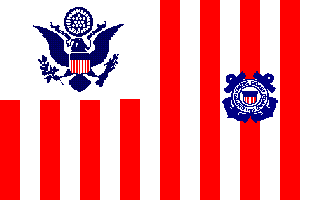
US Coast Guard Ensign
|
Ensign of the United States Coast Guard
The Coast Guard, like the Air Force, has two distinctive flags. One is an ensign for use by Coast Guard ships and cutters and shore establishments; the other is a military standard for use on ceremonial occasions.
The ensign is white with vertical red stripes and a white canton. In the canton is a dark blue U.S. Coat of Arms; in the fly is the Coast Guard badge. (The same flag, without the Coast Guard badge, is used by the U.S. Customs Service.) The Coast Guard Ensign is always flown together with the National Ensign, never on its own.
|
Flag
|
Flag
|
Flag
|
Flag
|
Flag
|
Flag
|
Flag
|
Flag
|
Flag
|
Flag
|
Flag
|
Flag
|
Flag
|
Flag
|
Flag
|
Flag
|
Flag
|
Flag
|
Flag
|
Flag
|
Flag
|
Flag
|
Flag
|
Flag
|
Flag
|
Flag
|
Flag
|
Flag
|
Flag
|
Flag
|
Flag
|
Flag
|
Flags of United States Joint Commands
The U.S. Armed Forces has or has had several Joint Service Commands, or Unified Combatant Command units. A Unified Combatant Command (UCC) is composed of forces from two or more services, usually has a broad or continuing mission, and is organized either on a geographical basis (Area Of Responsibility) or with a specific responsibility. These joint commands are commanded by either a four star general or admiral.
USLANTCOM Flag
|
United States Atlantic Command 1947-1999
The US Atlantic Command became the United States Joint Forces Command (USJFCOM) in 1999.
The Atlantic Command flag had the USACOM seal on a blue field
|
USREDCOM Flag
|
United States Readiness Command 1972-1987
|
USSTRICOM Flag
|
United States Strike Command 1961-1972
|

USJFCOM Flag
|
United States Joint Forces Command 1980-2010
The Joint Special Operations Command (JSOC) is a component command of the United States Special Operations Command (USSOCOM) and is charged to study special operations requirements and techniques to ensure interoperability and equipment standardization, plan and conduct special operations exercises and training, and develop Joint Special Operations Tactics. It was established in 1980. It is located at Pope Army Air Field and Fort Bragg in North Carolina, USA.
Officially JSOC is a joint-service "sub-unified command." A component command is service-specific, such as "Army Forces USSOCOM" or "Air Forces USCENTCOM." JSOC publically-identified mission and its actual mission are two entirely different things. In reality it performs the most highly classified and difficult special operations missions, such as the recent job in Pakistan.
|
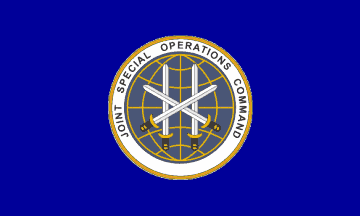
USSOCOM Flag
|
United States Special Operations Command
Functional Command HQ: MacDill AFB,
in Tampa, FL
|

USSOCOM Flag
|
United States Special Operations Command 1992
United States Strategic Command (USSTRATCOM) is one of the ten Unified Combatant Commands of the United States Department of Defense (DoD). The Command, including components, employs more than 2,700 people, representing all four services, including DoD civilians and contractors, who oversee the command´s operationally focused global strategic mission. Strategic Command was established in 1992 as a successor to Strategic Air Command (SAC). In October 2002, USSTRATCOM merged with the United States Space Command (USSPACECOM).
It is charged with space operations (such as military satellites), information operations (such as information warfare), missile defense, global command and control, intelligence, surveillance, and reconnaissance, global strike and strategic deterrence (the United States nuclear arsenal), and combating weapons of mass destruction.
USSTRATCOM is headquartered at Offutt Air Force Base south of Omaha, Nebraska.
|

USSPACECOM Flag
|
United States Space Command 1985-2002
The United States Space Command (USSPACECOM) was a Unified Combatant Command of the United States Department of Defense, created in 1985 to help institutionalize the use of outer space by the United States Armed Forces. The Commander in Chief of U.S. Space Command, with headquarters at Peterson Air Force Base, Colorado was also the Commander in Chief of the binational U.S.-Canadian North American Aerospace Defense Command (NORAD), and for the majority of time during USSPACECOM's existence also the Commander of the U.S. Air Force major command Air Force Space Command.
In 2002, it was merged with USSTRATCOM.
|
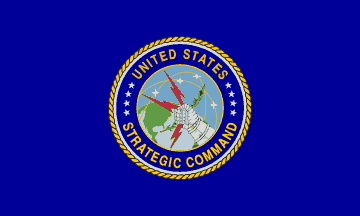
USSTRATCOM Flag
|
United States Strategic Command 2002-
HQ: Offutt AFB, in Omaha, NE
|

USAFRICOM Flag
|
United States Africa Command
The United States Africa Command (USAFRICOM or AFRICOM) is one of ten Unified Combatant Commands of the United States Armed Forces, headquartered at Kelley Barracks, Stuttgart, Germany. It is responsible for U.S. military operations and military relations with 53 African nations - an area of responsibility covering all of Africa except Egypt.
Regional command HQ: Kelley Barracks, in
Stuttgart, Germany
|
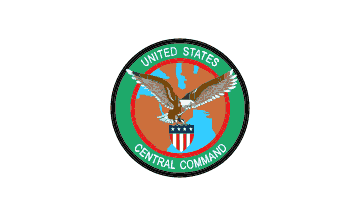
USCENTCOM Flag
|
United States Central Command
The United States Central Command (USCENTCOM) is a theater-level Unified Combatant Command unit of the U.S. armed forces, established in 1983 under the operational control of the U.S. Secretary of Defense. Its area of responsibility includes countries in the Middle East, North Africa, and Central Asia, most notably Afghanistan and Iraq.
Regional Command HQ: MacDill AFB, in Tampa, FL
|
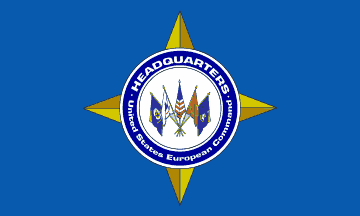
USEUCOM Flag
|
United States European Command
The United States European Command (EUCOM) is headquartered in Stuttgart, Germany. Its area of focus covers 51 countries and territories, including Europe, Russia, Iceland, Greenland, and Israel. The Commander of EUCOM simultaneously serves as the Supreme Allied Commander, Europe (SACEUR) within NATO.
Regional command HQ: Patch Barracks, in
Stuttgart, Germany
|
USPACOM Flag
|
United States Pacific Command 1947-
Regional command HQ: Camp H. M. Smith, in Honolulu, H
Pacific Command (PACOM) est., flag: PACOM seal on blue flag
|
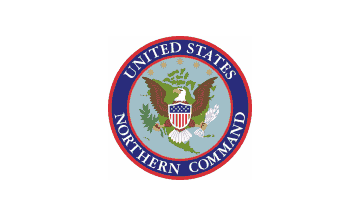
USNORTHCOM Flag
|
United States Northern Command 2002-
United States Northern Command (USNORTHCOM, or informally just NORTHCOM) is a Unified Combatant Command of the United States military. Created on October 1, 2002 in the aftermath of the September 11, 2001 attacks, its mission is to protect the United States homeland and support local, state, and federal authorities. The support that USNORTHCOM provides to civil authorities is limited by the Posse Comitatus Act which limits the role of the U.S. military in civil law enforcement.
USNORTHCOM´s Area of Responsibility (AOR) includes air, land and sea approaches and encompasses the contiguous United States, Alaska, Canada, Mexico and the surrounding water out to approximately 500 nautical miles (930 km). It also includes the Gulf of Mexico, the Straits of Florida, portions of the Caribbean region to include The Bahamas, Puerto Rico, and the U.S. Virgin Islands. Regional Command HQ: Peterson AFB, in
Colorado Springs, CO
|
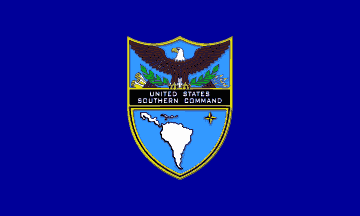
USSOUTHCOM Flag
|
United States Southern Command
The United States Southern Command (USSOUTHCOM), located in Miami, Florida, is one of ten Unified Combatant Commands (COCOMs) in the United States Department of Defense. It is responsible for providing contingency planning and operations in Central and South America, the Caribbean (except U.S. commonwealths, territories, and possessions), Cuba, their territorial waters, and for the force of U.S. military resources at these locations. USSOUTHCOM is also responsible for ensuring the militarization of the Panama Canal and canal area.
|
USTRANSCOM Flag
|
United States Transportation Command 1987
HQ: Scott AFB, in
St. Clair County, IL
|
Special Military Award Flags and Pennants of the United States
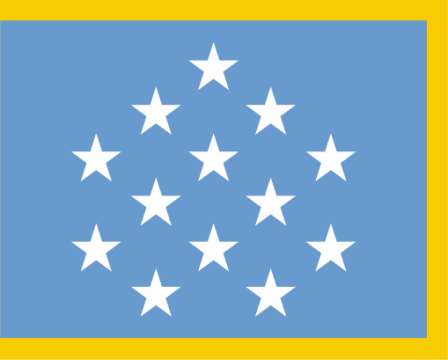
Medal of Honor Flag
(with fringe)
|
Medal of Honor Flag 2002
In 2002, President George W. Bush and Congress authorized a Medal of Honor flag to be presented to recipients of the decoration. The flag design was suggested by retired Army Special Forces First Sergeant Bill Kendall of Jefferson, Iowa. Kendall's design of a light blue field emblazoned with 13 white five-pointed stars was the basis of the flag suggested by Sarah LeClerc of the Institute of Heraldry. LeClerc's design, ultimately accepted as the official flag, does not include the words "Medal of Honor" as did Kendall's original design, and is fringed in gold. The color of the field and the 13 white stars, arranged in the form of a three bar chevron, consisting of two chevrons of five stars and one chevron of three stars, replicates the suspension ribbon of the Medal of Honor.
The first Medal of Honor recipient to receive the Medal of Honor flag was Sergeant First Class Paul R. Smith. The Medal of Honor with the flag was presented by President George W. Bush to his family during a ceremony at the White House on April 4, 2005. A special Medal of Honor Flag presentation ceremony was held for over 60 living Medal of Honor recipients on board the USS Constitution on September 30, 2006.
|
|